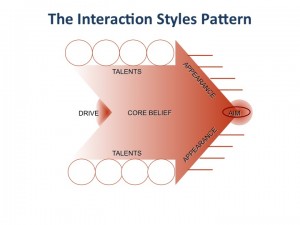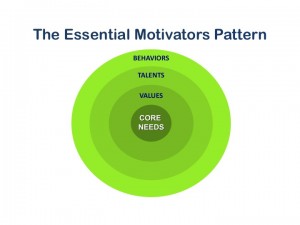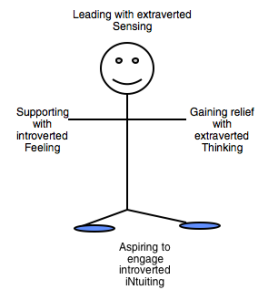This was the title of my 2-hour general session at the Association for Psychological Type International Conference, July 22, 2015. I was honored to be able to engage the attendees in this topic and I want to share some of the basic ideas with you here along with some additional thoughts I didn’t cover in the session.
“Don’t worry, be happy!” Easier said than done! Happiness is not just an upbeat mood. True happiness comes from a sense of well-being. Well-being is influenced by many factors including unconscious drivers of our behavior and of how we make meaning of the world. When these drivers are not satisfied, our capacity for effective communication suffers and we pop out of the Communication Zone and don’t communicate as effectively as we intend. Because we are social beings who need to have at least some sense of relatedness, good communication contributes to that sense of well-being.
The basic problem is one identified years ago by my colleague and friend, Dr. Sue Cooper. We all suffer from BLM Syndrome (Be Like Me). We expect others to be like us and when they aren’t we are sometimes pleased, but more often surprised, or angry, and worse—blaming and judgmental of them. I identified another related syndrome: BLT (Be Like Them). If we are trying to be like others we may not be tapping into our strengths and doing what creates that sense of well-being called ‘happiness.’ So how do we get out of BLM and BLT?
3 Strategies 4 Paths 5 Rules
The 3 Strategies
- Know Yourself
- Make Space (for others and yourself)
- Shift
 Coming to know yourself is a lifelong process and we are helped throughout our life with feedback from others and experiences that encourage self-reflection. As always we need to keep in mind that we have many ‘selves’ and the core self is what we are targeting to identify to get to true happiness. This does not discount the importance of the developed self or the contextual self.
Coming to know yourself is a lifelong process and we are helped throughout our life with feedback from others and experiences that encourage self-reflection. As always we need to keep in mind that we have many ‘selves’ and the core self is what we are targeting to identify to get to true happiness. This does not discount the importance of the developed self or the contextual self.
Once we know more about ourselves, we can actively make space for the use of our talents and the inclusion of our perspectives. And we can make space for the talents and perspectives of others, which gets us more into the Communication Zone since we then demonstrate an attitude of acceptance of others’ views with appreciation.
The more we appreciate and include others, the more open we are to shifting our own perspectives and communications to meet them at their view of the world. (I have written in detail how to do this with Interaction Styles in Interaction Essentials and will write more about these three strategies using the Essential Motivator lens in the forthcoming book, The Communication Zone.™)
The 4 Paths
It helps if we have some ways to help us see some of the unconscious drivers of our behaviors and of how we make meaning of the world. In the session I shared the essential qualities of four models of personality type as ‘paths’ to follow to know our selves better, make space for others, and shift our communications. Using these models as lenses can help us understand different aspects of the 16 personality types derived from Jungian theory beyond what looking at dichotomies can give us. Each of the lenses can stand alone, and they also integrate with the 16 types. No matter where you start, you can always add in another lens for deeper understanding.
For these models to provide a useful path, we need to look beyond dichotomies and preferences and identify …
- Patterns to find the Drivers, Values, Beliefs, Talents, and Stressors
- Processes—Dynamics, and Polarities that help use meet those drivers
They are named below and you can find more information here.
The first path is Interaction Styles with easy-to-identify energy patterns. This lens tells us ‘how’ we do what we do. First we need to identify the four patterns of interaction and the psycho-physiological drivers of those interactions. We are driven to interact with different energies, yet we can be flexible and shift into the other patterns. Just the names of each help us get a sense of the energy behind them.
- Chart-the-Course™
- In-Charge™
- Get-Things-Going™
- Behind-the-Scenes™
Then we can look at the dynamic polarities that serve those patterns.
- Directing—Informing Communications
- Initiating—Responding Roles
- Outcome—Process Focus.
The Interaction Styles are described in more detail in Understanding Yourself and Others, Introduction to Interaction Styles 2.0.
 The second path takes us deeper into Essential Motivators (aka Temperament). This lens tells us ‘why’ we do what we do. It gives us information about our deep psychological needs and values and helps us see our hidden agendas for how to approach problems and projects. The Essential Motivators usually operate outside our awareness so understanding these can greatly increase our own mastery of well-being and stress. The names used describe the themes and the talents of those themes give a brief sense of what they are about.
The second path takes us deeper into Essential Motivators (aka Temperament). This lens tells us ‘why’ we do what we do. It gives us information about our deep psychological needs and values and helps us see our hidden agendas for how to approach problems and projects. The Essential Motivators usually operate outside our awareness so understanding these can greatly increase our own mastery of well-being and stress. The names used describe the themes and the talents of those themes give a brief sense of what they are about.
- Improviser, with a talent for Tactics
- Stabilizer, with a talent for Logistics
- Theorist, with a talent for Strategy
- Catalyst, with a talent for Diplomacy
Dynamic polarities identify preferences for different ways to communicate and be in relationship:
- Abstract—Concrete language
- Affiliative—Pragmatic Roles
- Structure—Motive Focus
The Essential Motivator Lens is described in more detail in Understanding Yourself and Others, Introduction to the 4 Temperaments, 4.0.
The third path takes us deeper into understanding the patterns of each of the sixteen personality types—Cognitive Dynamics (aka type dynamics or 8 functions). Grounded in Jung’s eight mental processes, this lens tells us “where and when” we are likely to use different processes for accessing information and making decisions. But even more, it can inform us of our heroic self and our self-destructive self. It isn’t just about what functions we prefer, but how we tend to use them. We are driven to use one process as a leading role because it is most satisfying to heroically save the day. When that process is focused inward, Jungian theory says we are introverted and when it is focused on the external world, it says we are extraverted. However, we have preferred processes that are used in the other attitude and provide balance to our lives. By recognizing the dynamic interplay of these processes and the basic pattern with the roles that each process tends to fall into we can notice when we are stuck and find ways to reenergize, foster development, and get out of stress responses. (See Understanding Yourself and Others, An Introduction to the Personality Type Code for more information)
 The fourth path is newly recognized and looks at the cognitive processes in a different way so we called it Cognitive Styles at first, then changed the name to Intentional Styles. If we cluster the sixteen types differently, we can see four Intentional Styles: Enhancing, Customizing, Authenticating, and Orchestrating. You can read more about this emerging model here. Stay tuned as it evolves and Chris Montoya and I continue our research.
The fourth path is newly recognized and looks at the cognitive processes in a different way so we called it Cognitive Styles at first, then changed the name to Intentional Styles. If we cluster the sixteen types differently, we can see four Intentional Styles: Enhancing, Customizing, Authenticating, and Orchestrating. You can read more about this emerging model here. Stay tuned as it evolves and Chris Montoya and I continue our research.
[Note for practitioners: Knowing about the essential qualities of these multiple lenses provides information that the standard dichotomies or other lenses do not. They help us clarify type and type look-alikes as well as give us multiple entry points and more applications in working with clients.]
The 5 Rules
The five rules provide us with actions we can take as we continue our journey to well-being and happiness in the Communication Zone.
- Honor the Core Driver of each pattern. Unmet psychological needs leads to stress and severe unhappiness. Unmet Interaction Style drives create tension in the body as well as in the mind and can lead to ineffective communication and lack of rapport. Ignoring the strong drive of the leading role process of our full type can lead to frustration and not heeding its strength as well as trying to dominate a communication. Blindly following our unconscious intentions can lead to ineffective approaches and needless conflict.
- Align with values, beliefs, and rationales. These are strongly held aspects of our being and by knowing the values, beliefs, and rationales that are part of the four patterns, we can better feel that sense of satisfaction and well-being when they are all aligned with the activities of our lives. They also provide us with information about aspects of our purpose in life that we must have for deep happiness.
- Engage the talents. I often say that the talents of each lens gives us the means to scratch the itch that the needs and drivers create. Find ways to use your talents and honor the talents of others!
- Observe behaviors (your own and others). Pay attention to when you or others are stressed and ask the question, “Why does this behavior make sense?” It might be that a core need is not being met. How can you help get it met? And pay attention to current behavior as a clue that something other than the meeting the core driver is needed. We do have all these needs within us and at times they surface as well so we can be responsive to a situation. Pay attention. Be mindful.
- Hold the lenses lightly. Avoid labeling and insisting that everything must follow the patterns. They are not boxes to be trapped in. They are not the absolute truth, but just useful models that can help us make sense of the world and find some Happiness in The Communication Zone.


